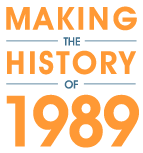Scholar Interviews
Questions
- What were your experiences of 1989?
- How have your ideas changed?
- How did you research 1989?
- Did your research lead to a new interpretation?
- Is there one moment that stands out for you personally?
- One crucial moment of 1989?
- What led to the Round Table Talks?
- What sources help us understand the strikes?
- What is significant about the leaflet?
- How do you analyze the leaflet?
- Does this poem help explain the strike?
- What is remarkable about the poem and the leaflet together?
- What is significant about the poem?
- How should students interpret the poem?
- How is Solidarity viewed today?
How did you research 1989?
Transcription
As I began to work on 1989, my first step was to go into the archives and read the underground literature as much as I could and I began with Poland. Poland remained a major focus throughout, although I then began to work with Czech, Slovak, and Ukrainian sources as well. But in the Polish case, there are somewhere between a thousand and two thousand different underground periodicals. I essentially began to read everything that I could because I couldn’t simply rely on my own memory of those events and to be honest, you know, I may have been there through much of the last few years of Communism but I was not a participant.
I was not even really an active reader of underground literature. And by underground literature, I mean the periodicals that were being produced by Solidarity at all levels, by factories, schools, churches, you name it. People producing periodicals of a more or less, regular nature, some of them quite ephemeral. And so I was simply trying to get a sense of what was going on all across Solidarity and sort of looking for traces of what I felt was a change that was taking place in the latter half of the 1980s.
And that led me in particular to look at periodicals produced by new types of social movements allied to Solidarity, but not necessarily within Solidarity, that as it turns out do emerge all across Poland beginning as early as 1984 and really picking up the pace by 1986. I was trying to understand who were these people. What were their goals, what were they like and then I began to try to find them. My first steps were to interview people I knew that I had met as a student in 1986-87, when I’d first gone to Poland.
I was essentially interviewing friends or acquaintances and saying to them, “well, I wasn’t really paying attention to what was going on when we first met; now, can you explain it to me?” And then had them refer me to others, sort of a snowball kind of effect. In other cases, I was able to find people using the underground literature. The people involved in these new movements from those last few years of Communism would put their names and addresses and phone numbers in these periodicals even though they were underground whereas in the past you might use pseudonyms. Here they were saying “this is who I am, this is where I live, this is how you can find me.” And so in some cases, I would simply call them up cold and say, well: I’m a historian from the United States and I’m doing this project and I’d like to interview you. Can we meet?
The word I use in my writing on 1989 is that these people were concrete, that they had a kind of down-to-earth sense of what political change should look like. And this is a contrast to sort of the manifesto-writing intellectuals who might write about the need for democratic change or the importance of civil society or national pride or dignity. But what do they exactly mean in practice?
The way I always describe this to my students is, if you go out onto the main square of your campus with a sign saying “Democracy Now,” people might say, “yeah, that’s true,” but they’re not going to follow you because they’ll say: what’s the point here? Whereas if your sign says, “Fire the President” or “we need clean water in our dormitories” or “more safety on campus” in some specific way, well, then that’s something that people can follow.
And, you know, while I could see this in the documents, when I started interviewing people, that kind of concreteness really came through in the way they would speak. If you speak to someone who is more of a manifesto type, every response to every question will be, you know, a kind of a philosophical digression. But people who were shaped, and themselves shaped, as a kind of concrete politics would have very precise and pragmatic answers to any question. They would speak in local terms rather than global terms. There’s not a kind of a bashfulness about politics that would come through.
How to Cite
Padraic Kenney, interview, "How did you research 1989?" Making the History of 1989, Item #584, https://chnm.gmu.edu/1989/items/show/584 (accessed May 28 2021, 3:25 pm).
